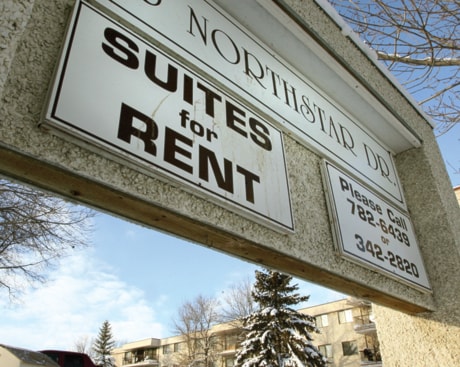A silver lining has emerged from the economic cloud hanging over Alberta — at least for those living in rental accommodations.
Vacancy rates are up and rents are down throughout the province, according to Canada Mortgage and Housing Corp.’s fall rental market survey.
The national housing agency reported on Wednesday that the average vacancy rate for private rental apartments in Alberta urban centres with 10,000 or more people was 5.5 per cent in October, up from 2.5 per cent a year earlier. The average rent was $949, as compared with $975 in October 2008.
Lai Sing Louie, a regional economist with CMHC, said in a news release that reduced employment levels in Alberta — particularly among younger people — contributed to the year-over-year change.
“A lower level of employment opportunities has also reduced migration flows from non-permanent residents, a group that has a high propensity to rent,” added Louie. “These factors, combined with strong home ownership demand among first-time buyers and competition from the secondary market, has resulted in the increase in vacant rental apartment units.”
The secondary market refers to accommodations not built specifically for rental.
In Red Deer, the average vacancy rate for all types of apartments in October was 9.2 per cent. That compares with an October 2008 figure of 4.4 per cent.
When it comes to the cost of renting those apartments, the average was $793, down from $818 a year earlier.
The biggest jump in local average vacancy rates was in the three-bedroom category, which rose to 9.8 per cent from 2.2 per cent. The average for one-bedroom apartments increased five percentage points to 8.7 per cent, two-bedroom suites jumped to 9.8 per cent from 4.9 per cent, and bachelor units were up 0.7 percentage points to 6.4 per cent.
Average monthly rents were down for all apartment types in October: to $938 from $1,038 in the case of three-bedroom units, to $850 from $876 for two-bedroom apartments, to $603 from $624 for bachelor suites, and to $725 from $736 for one-bedroom units.
The rise in vacancy rates reflects a trend noted in CMHC’s 2008 fall rental market survey, which showed that the average October figure for Alberta’s large urban centres increased nearly a full percentage point from 1.6 per cent in 2007.
However, average rents rose by $62, from $913, during the same period.
CMHC’s rental market survey also considered apartments in Lacombe and Sylvan Lake.
In Lacombe, the overall average vacancy rate in October was 9.3 per cent, up from three per cent 12 months earlier. The average rent declined to $697 from $705.
In Sylvan Lake, the vacancy rate was 7.1 per cent, as compared with 2.8 per cent the previous October. The average rent in the resort community increased to $766 from $685 during the year.
Across the province, average vacancy rates ranged from 3.2 per cent in Cold Lake and Okotoks, to 9.5 per cent in Brooks and 15.5 per cent at Grande Prairie.
The lowest average rent was $655 in Medicine Hat, while the highest was $2,040 in the Regional Municipality of Wood Buffalo, the region that includes Fort McMurray.
hrichards@www.reddeeradvocate.com
